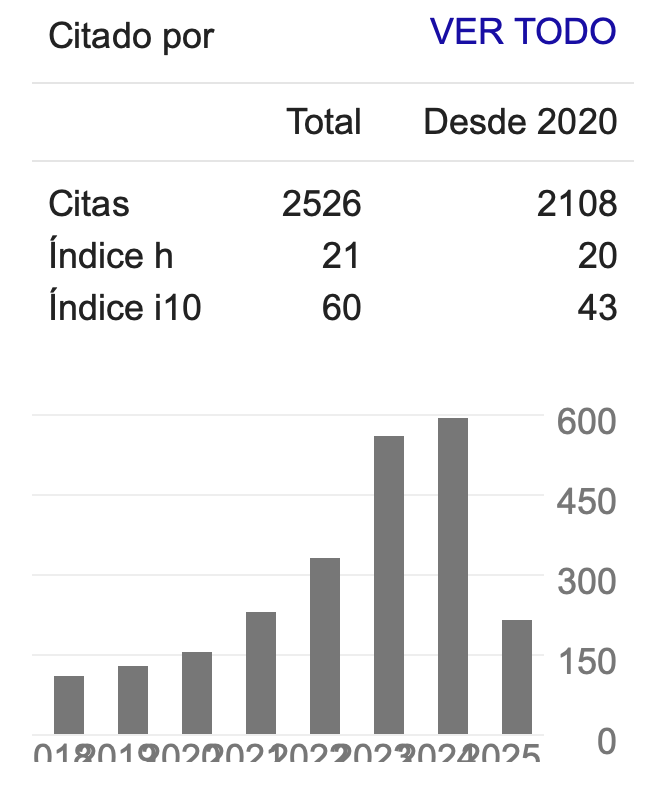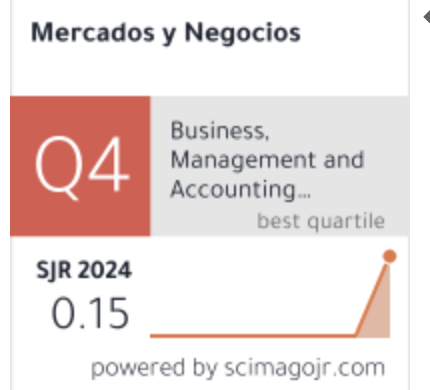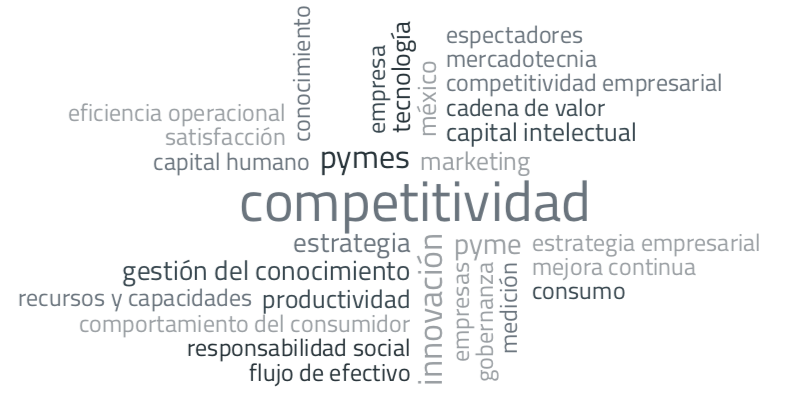Branding interno en organizaciones de comercio minorista: un estudio en una cadena de farmacias
DOI:
https://doi.org/10.32870/myn.v1i42.7506Keywords:
branding interno, promesa de marca, marcas de servicio, valores de marca, satisfacción laboral, comercio minoristaAbstract
El objetivo del artículo es introducir el concepto de branding interno en la literatura organizacional publicada en México, distinguiéndolo de conceptos relacionados como el marketing interno y el branding del empleador. El método consistió en la estimación de un modelo de ecuaciones estructurales usando Mínimos Cuadrados Parciales con una muestra de 310 encuestas de empleados de una cadena grande de farmacias. Los resultados muestran una relación positiva entre el ajuste con los valores de marca de los empleados y su satisfacción laboral, intención de permanencia y conducta alineada con la marca. El hallazgo principal es que el branding interno rebasa el ámbito exclusivo del marketing e incide también en objetivos tradicionales de recursos humanos, como la satisfacción e intención de permanencia de los colaboradores.References
Altaf, M., Mokhtar, S. S., & Ghani, N. H. (2017). Employee critical psychological states as determinants of employee brand equity in banking: A multi-group analysis. Banks and Bank Systems, 12(3), 61-73.
Anees-ur-Rehman, M., Wong, H. Y., & Merrilees, B. (2018). How brand-oriented strategy affects the financial performance of B2B SMEs. Journal of Business & Industrial Marketing, 33(3), 303-315.
Aurand, T. W., Gorchels, L., & Bishop, T. R. (2005). Human resource management's role in internal branding: an opportunity for cross-functional brand message synergy. Journal of Product & Brand Management, 14(3), 163-169.
Backhaus, K., & Tikoo, S. (2004). Conceptualizing and researching employer branding. Career Development International, 9(5), 501-517.
Bagozzi, R. P., & Yi, Y. (1988). On the evaluation of structural equation models. Journal of the Academy of Marketing Science, 16(1), 74-94.
Baker, T. L., Rapp, A., Meyer, T., & Mullins, R. (2014). The role of brand communications on front line service employee beliefs, behaviors, and performance. Journal of the Academy of Marketing Science, 42(6), 642-657.
Barney, J. B. (2014). How marketing scholars might help address issues in resource-based theory. Journal of the Academy of Marketing Science, 42, 24-26.
Becerra, M., Silva, R., & Gerwe, O. (2016). Competitiveness and performance of chain hotels. En M. Ivanova, M. Ivanov, & V. Magnini (Edits.), The Routledge Handbook of Hotel Chain Management (págs. 373-382). Routledge.
Berry, L. L., & Parasuraman, A. (1992). Services marketing starts from within. Marketing Management, 1(1), 24-34.
Blasco-López, M. F., Rodríguez-Tarodo, A., & Fernández-Lores, S. (2014). Employer branding: estudio multinacional sobre la construcción de la marca del empleador. Universia Business Review, (44), 34-53.
Boukis, A., & Christodoulides, G. (2018). Investigating key antecedents and outcomes of employee-based brand equity. European Management Review. https://doi.org/10.1111/emre.12327
Boukis, A., Kaminakis, K., Siampos, A., & Kostopoulos, I. (2015). Linking internal marketing with customer outcomes. Marketing Intelligence & Planning, 33(3), 394-413.
Buil, I., Martínez, E., & Matute, J. (2016). From internal brand management to organizational citizenship behaviours: Evidence from frontline employees in the hotel industry. Tourism Management, 57(1), 256-271.
Burmann, C., & Zeplin, S. (2005). Building brand commitment: A behavioural approach to internal brand management. Journal of Brand Management, 12(4), 279-300.
Burmann, C., Zeplin, S., & Riley, N. (2009). Key determinants of internal brand management success: An exploratory empirical analysis. Journal of Brand Management, 16(4), 264-284.
Cable, D., & Judge, T. (1997). Interviewers' Perceptions of Person--Organization Fit and Organizational Selection Decisions. Journal of Applied Psychology, 82(4), 546-561.
Castellano, S., & González, P. (2010). Calidad de servicio en farmacias tradicionales y de autoservicio: Estudio de caso. Revista Venezolana de Gerencia, 15(52), 570-590.
Chad, P. (2016). Corporate rebranding: An employee-focused nonprofit case study. 28(4), 327-350.
Chiang, H.-H., Han, T.-S., & McConville, D. (2018). The attitudinal and behavioral impact of brand-centered human resource management: Employee and customer effects. International Journal of Contemporary Hospitality Management, 30(2), 939-960.
Chin, W. W. (1998). The partial least squares approach to structural equation modeling. En G. A. Marcoulides (Ed.), Modern Methods for Business Research (págs. 295-358). Lawrence Erlbaum Associates.
De Chernatony, L. (1999). Brand Management Through Narrowing the Gap Between Brand Identity and Brand Reputation. Journal of Marketing Management, 15(1-2), 157-179.
De Farias, S. A. (2010). Internal Marketing (IM): a literature review and research propositions for service excellence. Brazilian Business Review, 7(2), 99-115.
Dekker, D. M. (2014). Personality and hospitable behavior. En I. S. Pantelidis (Ed.), The Routledge Handbook of Hospitality Management (págs. 75-84). Routledge.
Du Preez, R., & Bendixen, M. T. (2015). The impact of internal brand management on employee job satisfaction, brand commitment and intention to stay. International Journal of Bank Marketing, 33(1), 78-91.
Du Preez, R., Bendixen, M., & Abratt, R. (2017). The behavioral consequences of internal brand management among frontline employees. Journal of Product & Brand Management, 26(3), 251-261.
Erkmen, E., & Hancer, M. (2015). Linking brand commitment and brand citizenship behaviors of airline employees:“The role of trust”. Journal of Air Transport Management, 42(1), 47-54.
Fernandez-Lores, S., Gavilan, D., Avello, M., & Blasco, F. (2016). Affective commitment to the employer brand: Development and validation of a scale. BRQ Business Research Quarterly, 19(1), 40-54.
Figueroa-Moya, M. P., & Serralde-Rodríguez, A. (2003). Marketing interno como ventaja competitiva en concesionarias Kenworth. (Tesis de Licenciatura). Departamento de Administración de Empresas, Universidad de las Américas Puebla. http://catarina.udlap.mx/u_dl_a/tales/documentos/lad/figueroa_m_mp/
Grönroos, C. (2015). Service management and marketing: managing the service profit logic. John Wiley & Sons.
Guerrero-Martínez, D. G. (2012). Factores clave de éxito en el negocio del retail. Ingeniería Industrial, 30(1), 189-205.
Hair, J. F., Hult, T. M., Ringle, C. M., & Sarstedt, M. (2017). A Primer on Partial Least Squares Structural Equation Modeling (PLS-SEM), 2nd Ed. Sage.
Harkness, J. A. (2003). Questionnaire translation. En J. A. Harkness, F. van de Vijver, & P. P. Mohler (Edits.), Cross-cultural Survey Methods (págs. 35-56). John Wiley & Sons.
Henseler, J., Ringle, C. M., & Sinkovics, R. R. (2009). The Use of Partial Least Squares Path Modeling in International Marketing. Advances in International Marketing (AIM), 20(1), 277-320.
Hernández, R., & Mendoza, C. P. (2018). Metodología de la Investigación. Las Rutas Cuantitativa, Cualitativa y Mixta. McGraw Hill.
Hurrell, S. A., & Scholarios, D. (2014). “The People Make the Brand” Reducing Social Skills Gaps Through Person-Brand Fit and Human Resource Management Practices. Journal of Service Research, 17(1), 54-67.
Iglesias, O., Markovic, S., & Rialp, J. (2019). How does sensory brand experience influence brand equity? Considering the roles of customer satisfaction, customer affective commitment, and employee empathy. Journal of Business Research, 96(1), 343-354.
Itam, U., & Singh, S. (2017). Examining the mediation effect of employee engagement on internal brand practices and outcome variables in the organized retail sector. International Business Management, 11(3), 673-682.
Kandampully, J., Zhang, T., & Jaakkola, E. (2018). Customer experience management in hospitality: A literature synthesis, new understanding and research agenda. International Journal of Contemporary Hospitality Management, 30(1), 21-56.
Keller, K. L., & Swaminathan, V. (2019). Strategic brand management: building, measuring, and managing brand equity. Pearson Education.
King, C., & So, K. K. (2015). Enhancing hotel employees’ brand understanding and brand-building behavior in China. Journal of Hospitality & Tourism Research, 39(4), 492-516.
Krystallis, A., & Chrysochou, P. (2014). The effects of service brand dimensions on brand loyalty. Journal of Retailing and Consumer Services, 21(2), 139-147.
Lievens, F., & Slaughter, J. E. (2016). Employer image and employer branding: What we know and what we need to know. Annual Review of Organizational Psychology and Organizational Behavior, 3(1), 407-440.
Littlewood, H. F. (2006). Antecedentes de la rotación voluntaria de personal. Investigación Administrativa, 35(97), 7-25.
Liu, G., Ko, W. W., & Chapleo, C. (2017). Managing employee attention and internal branding. Journal of Business Research, 79, 1-11.
Löhndorf, B., & Diamantopoulos, A. (2014). Internal branding: Social identity and social exchange perspectives on turning employees into brand champions. Journal of Service Research, 17(3), 310-325.
Murillo, E. (2016). Branding interno: desarrollando embajadores de marca. Dirección Estratégica(57). http://www.academia.edu/download/55865707/Murillo_2016_Direccion_Estrategica.pdf
Murillo, E. (2019). El branding interno como antecedente de la autoestima basada en la organización: un estudio en una cadena de restaurantes. Entreciencias: Diálogos en la Sociedad del Conocimiento, 7(21), 37-52. http://dx.doi.org/10.22201/enesl.20078064e.2019.21.70046
Murillo, E., & King, C. (2019). Examining the drivers of employee brand understanding: a longitudinal study. Journal of Product & Brand Management, 28(7), 892-907.
Nguyen, H., Groth, M., Walsh, G., & Hennig-Thurau, T. (2014). The impact of service scripts on customer citizenship behavior and the moderating role of employee customer orientation. Psychology & Marketing, 31(12), 1096-1109.
Nyadzayo, M. W., Matanda, M. J., & Ewing, M. T. (2015). The impact of franchisor support, brand commitment, brand citizenship behavior, and franchisee experience on franchisee-perceived brand image. Journal of Business Research, 68(9), 1886-1894.
O'Reilly III, C. A., Chatman, J., & Caldwell, D. F. (1991). People and organizational culture: A profile comparison approach to assessing person-organization fit. Academy of Management Journal, 34(3), 487-516.
Park, J. H., & Tran, T. B. (2018). Internal marketing, employee customer-oriented behaviors, and customer behavioral responses. Psychology & Marketing, 35(6), 412-426.
Piehler, R. (2018). Employees’ brand understanding, brand commitment, and brand citizenship behaviour: a closer look at the relationships among construct dimensions. Journal of Brand Management, 25(3), 217-234.
Piehler, R., Grace, D., & Burmann, C. (2018). Internal brand management: introduction to the special issue and directions for future research. Journal of Brand Management, 25(3), 197-201.
Pinar, M., Girard, T., Trapp, P., & Eser, Z. (2016). Services branding triangle: Examining the triadic service brand promises for creating a strong brand in banking industry. International Journal of Bank Marketing, 34(4), 529-549.
Pine, B. J., & Gilmore, J. H. (2017). Distinctive experiences. Journal of Shopper Research, 1(1), 60-65.
Porricelli, M. S., Yurova, Y., Abratt, R., & Bendixen, M. (2014). Antecedents of brand citizenship behavior in retailing. Journal of Retailing and Consumer Services, 21(5), 745-752.
Punjaisri, K., & Wilson, A. (2011). Internal branding process: key mechanisms, outcomes and moderating factors. European Journal of Marketing, 45(9/10), 1521-1537.
Reinartz, W., Haenlein, M., & Henseler, J. (2009). An empirical comparison of the efficacy of covariance-based and variance-based SEM. International Journal of Research in Marketing, 26(4), 332-344.
Ringle, C. M., Wende, S., & Becker, J.-M. (2015). SmartPLS 3. SmartPLS GmbH.
Saleem, F. Z., & Iglesias, O. (2016). Mapping the domain of the fragmented field of internal branding. Journal of Product & Brand Management, 25(1), 43-57.
Schmidt, H. J., & Baumgarth, C. (2018). Strengthening internal brand equity with brand ambassador programs: Development and testing of a success factor model. Journal of Brand Management, 25(3), 250-265.
Schneider, B. (1987). The people make the place. Personnel Psychology, 40(3), 437-453.
Terglav, K., Ruzzier, M. K., & Kaše, R. (2016). Internal branding process: Exploring the role of mediators in top management's leadership-commitment relationship. International Journal of Hospitality Management, 54(1), 1-11.
Tuominen, S., Hirvonen, S., Reijonen, H., & Laukkanen, T. (2016). The internal branding process and financial performance in service companies: An examination of the required steps. Journal of Brand Management, 23(3), 306-326.
Vatankhah, S., & Darvishi, M. (2018). An empirical investigation of antecedent and consequences of internal brand equity: Evidence from the airline industry. Journal of Air Transport Management, 69(1), 49-58.
Wirtz, J., & Lovelock, C. (2016). Services Marketing: People, Technology, Strategy. World Scientfic Publishing.
Wirtz, J., & Zeithaml, V. (2018). Cost-effective service excellence. Journal of the Academy of Marketing Science, 46(1), 59-80.
Xiong, L., & King, C. (2015). Motivational drivers that fuel employees to champion the hospitality brand. International Journal of Hospitality Management, 44(1), 58-69.
Xiong, L., & King, C. (2019). Aligning employees’ attitudes and behavior with hospitality brands: The role of employee brand internalization. Journal of Hospitality and Tourism Management, 40(1), 67-76.
Yaniv, E., & Farkas, F. (2005). The impact of person-organization fit on the corporate brand perception of employees and of customers. Journal of Change Management, 5(4), 447-461.
Published
How to Cite
Issue
Section
License
Mercados y Negocios by Department of Mercadotecnia y Negocios Internacionales. University of Guadalajara is licensed under a License Creative Commons Attribution-NonCommercial 4.0 International.
The author retains the copyright.








